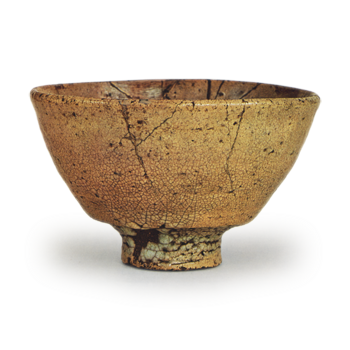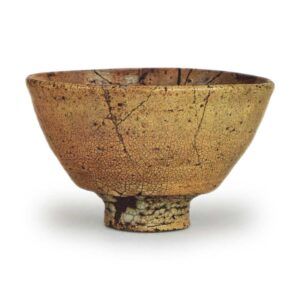
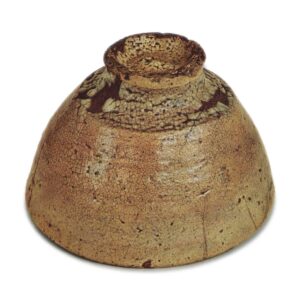
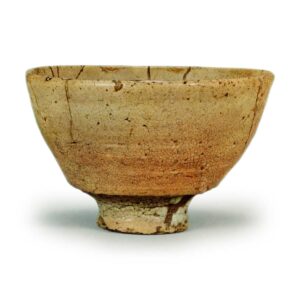
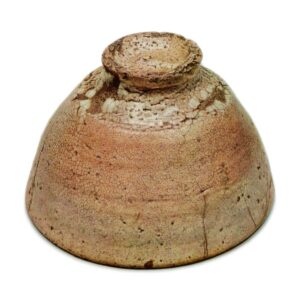
Oido Tea Bowl, Tsutsuizutsu
Important Cultural Property
Height: 9.3-9.8cm, Bowl diameter: 15.2-15.5cm, Outer diameter of stand: 5.6-5.7cm, Height of same: 1.9cm
Attachment: Inner box, with paulownia wood and calligraphy by Kanamori Sowa, Outer box, with black lacquered three-part calligraphy in gold-powder script, back of the same lid, pasted with calligraphy.
Attributed to: Junkei Tsutsui – Hideyoshi Toyotomi – Bishamondo Monzeki of Yamashina
Published in: Rikyu Hyakkai Kai Kai, Chodanedo Ki, Sequel to Tea Talks by Shinmukai O, Taisho Meikikan (Taisho Meikikan)
There are about fifty Oido teabowls that I have examined, and no one would disagree that Kizaemon and Tsutsui Tsutsui are the two best in terms of their dignity and gravity. To sum up the characteristics of the two bowls in a few words, Tsutsuizutsu can be said to be the most prestigious and Kizaemon can be said to be the most dignified.
The characteristic of Tsutsuizutsu is its shape, that is, the balance between the width from the base to the mouth and the height of the whole body is maintained very well, and the shape from the side is more three-dimensional because the edge of the base is cut deeply and boldly. In addition, the thickness of the bowl is well proportioned to the overall size, and even the thickness of the glaze has a good “ma” (space) that is hard to describe.
The entire surface is completely covered with a glaze commonly referred to as loquat color, but a closer look reveals that the simple glaze surface is also thick and thin, thus creating a rough, fine and subtle scene of penetration, and the rough and varied kairagi at the bottom of the bowl makes the whole piece look tighter and stronger. Despite the presence of large and small cracks as described in an anecdote, it retains the grandeur of its former appearance and has not lost any of its charm.
It is assumed that the well tea bowl displayed with the Shinden hoshaju at the Kitano Grand Tea Ceremony held on October 1, Tensho 15, where Hideyoshi himself served tea, may have been this tsutsuizutsu, and the inscription on the back of the outer box reads, “……Fengtomi Hideyoshi, for the Kitano Grand Tea Ceremony. The note on the back of the outer box says, ” was used at the Great Tea Ceremony held by Fonetomi Hideyoshi in Kitano.” It is said that the tea bowl was damaged by mistake at that time, but was repaired, and thus was named Tsutsuizutsu in later generations. The article on September 13, Tensho 18 in “Rikyu Hyakkai-ki” tells that “tsutsuno-ito tea bowl” was used at a tea ceremony held for Hideyoshi in a tea room with two tatami mats, but it may be that Rikyu used a tea bowl belonging to Hideyoshi at Rikyu’s residence in Juraku-dai, or that it was in his possession at one time.
The name “Tsutsui no Ito” is said to have originally belonged to Junkei Tsutsui, but records are inconclusive. The origin of the change to “tsutsui tsutsu” dates back to when it was accidentally broken when in Hideyoshi’s possession and Hosokawa Yusai, on the spot, improvised a mad song, “tsutsui tsutsu no tsutsu ni kake shi ido chawan to ga wa waga ni ohini kerashina,” a pun on a passage from “Ise Monogatari” to try to put Hideyoshi in a good mood, according to “Chouyadoki” and “Hosokawa Family Record The inscription on the inner box is also a cracked piece of paper. Therefore, the inscription on the inner box seems to have been made after the cracks were repaired, probably in Tensho 18. It is thought that the inscription on the inner box was made after the cracks were repaired, probably after the tea ceremony in Tensho 18.
After a certain period of time, until around 1950 or 1961, it was brought to Bishamonji Temple in Kyoto. It is not known when it became a fixture of the temple. However, it is said that Koetsu presented a tea bowl of his own work to Bishamondo, or Rinnoji Temple, from Genna to Kan’ei periods, which suggests that it probably entered the temple in the early Edo period and passed on as it was.
The inscription “Tsutsui-tsutsu” on the front of the inner box cover is attributed to Kanamori Munekazu in the Taisho Meikiki-kan, but the format in which only the name is written in three characters is similar to the inscription on a Shigure by Koetsu, which is attributed to Rosho Hojinsho of Manjuin Palace.

